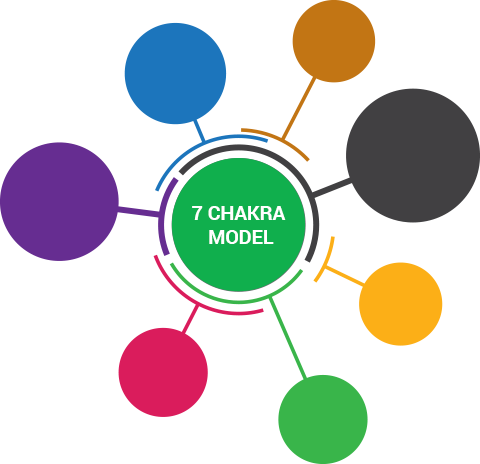
7 Chakra
Idealization of Machine, Manpower, and wastage to ascertain productivity and growth
Industries worldwide have been plagued by poor productivity and growth. Although they are investing in useful resources, the companies are still striving to achieve standard quality. And, it is severely affecting their market position as they are unable to meet their customers’ demands on the promised time and with full quality. Moreover, things are more dismal especially in a developing country like India.
Dream about high productivity than higher revenue, the new wave of ‘value-added per hour’ is taking the industries by storm.
Industries are keen to invest in newer machinery and equipment to stay ahead of the competition. But, they are completely overlooking the importance of labor productivity and its impact on their bottom line. While saving cost and increasing revenue are what every industrialist dreams of, there is a need to take a paradigm shift and concentrate more on increasing productivity and reducing waste.
The productivity per hour has fallen by more than 50%. One explanation is that there is no realization of effective utilization of Manpower, Material, and Machines for a given production. Another reason is that the Quality, Quantity, Time, and Cost concerning Manpower, Material, and Machines are not evaluated and predefined.
The Problem of Productivity is in Three Folds in Every Industry
A rigorous evaluation of ‘what needs to be produced’ against’ what is produced’ with respect to quality, cost, and customer expectations is essential.
Low Productivity of Manpower
In a business day of 8 hours, people work for 2.4-3 hours daily. The productivity is substantially flat and is in between 30-50%.
Low Productivity of Machines
The machines can operate for 24x7, where they only run for roughly 8 to 14 hours keeping the productivity to 30-40%.
Low Productivity of Materials
The process variability promotes overconsumption of materials and causes production defects, procurement mistakes resulting into decreased productivity.
What your business lacks
Process Auditing and Standardization
Your business activities are not designed and aligned with your customers’ expectations.
There is no real-time monitoring and tracking of the activities performed in a day.
Most of your business activities are focused on ‘finishing the project’ than valuing quality, time, and productivity.
There are many non-value adding parameters and failures occurring within the processes that you are unaware of. This is directly impacting your bottom line.
Tool to measure productivity
There is no measurement system or tool to calculate productivity. The essence of productivity is missing. If you do not have a measurement system to calculate productivity, you would believe that the work is being done at full capacity and on time. But, this is not the case. Customer fulfillment is still absent.
Correct division of labor
‘Attendance= working’ usually this defines your business output for a day. There is no clarity of ‘who’ is doing ‘what’ amount of work daily. Due to this, over-fragmentation of labor takes place.
The result is that, with the same technology, machine, and similar plant capacity, you employ five times more people.
Realization of wastage
Machine productivity is directly influenced by people productivity when wastage of material is eliminated and the inputs given to the machine are appropriate. In the absence of labor productivity, the goods produced by machines are rejected in the quality test. This increases the cost, wastage, and input with each such production.
Remember that ‘low quality = more wastage’ of Material, Manpower, and Machine.
What your business needs
Your business needs the ability to deliver the same or more output with less resource. You need a highly productive team that is responsible for covering an array of business results with lower overhead and increased revenue. It requires being faster in meeting the customers’ demands “on-time” and “in-full” quality.
To address the abovementioned issues, PBOPlus offers you the 7Chakra Model which is our patented solution to improve your productivity and business growth. We employ 7 Chakra to evaluate your processes and also idealize the use of Machine, Manpower, and Materials and define the minimum waste.
All the Chakras in the model can be categorized as follows:

Process Chakra
At the outset, we must decipher the meaning of the word “Process” to understand this Chakra. Whatever happens in the universe happens as per a Process. Hence, a bundle of activities that are combined to deliver an outcome can be called as a Process. In a business sense, the outcome is always delivered to a customer.
We firmly believe that:
- Most of the processes in the industry have 80 – 90 percent Non-Value-Adds (NVAs)*.
- Quality of the outcome that is delivered to a customer is marginal and varies mostly between 10-50%.
- Quantity of the outcome with respect to man-to-machine ratio is very low.
- Process sense and business alignment are lacking.
Finishing the project “On-Time” is a major reason of worry for most owners. They often fail to deliver the outcome on the promised time.
* The components of value – chain that are waste and have no favorable effect on the bottom – line of the production.
All of this translates into bad productivity. It is important to understand that your business is alive as long as your processes are standardized.
PBOPlus defines the processes for clients and enables them to deliver the desired outcome for their customers without compromising on the Quality, Quantity or Time. We revamp the existing processes and work on eliminating all the NVAs from the same.
As a part of the Process Chakra, we do the following:
- Map the entire process scientifically by filming
- Identify Bottlenecks/NVAs in the process
- Calculate the changeover time for all operations
- Calculate and implement standard times of processes
- Define the capability index

Structure Chakra
Typically, an organization has 12-18 layers of hierarchy. However, the situation has improved, and it has come down to 5-6 layers.
However, to minimize the chaos and disorder in the world of processes, PBOPlus defines a 3- layered inverted structure.
This structure is based on the concept that “Arjuna – in execution” is connected to “Dronacharya – the coach” is connected to “Krishna – the strategist.”
Our 3 – layered inverted structure consists of the following teams:
- HPPT Team (High-Performance Process Team): The front line workers that do the “days work” supported by zero-delay services.
- PAICC Team (Plan-Analyze-Improve-Coach-Certify Team): The managers or supervisors responsible for improvement initiatives and continual improvement.
- ADUM Team (Add-Delete-Upgrade-Modify Team): The HODs responsible for non-linear change and Adding, Deleting, Upgrading, and Modifying processes to derive transformational outcomes.

People Chakra
PBOPlus believes that every process must have multifunctional manpower (all-rounder) running it. If each man knows only one function alone, the cost of production will be high, and the productivity will be less.
As a part of driving transformation through the People Chakra, PBOPlus focuses on the multi-functioning of people and connecting them with processes. We build 3 alternates per process (3 functions per person) by cross – training.
As a part of the People Chakra, we do the following:
- Optimize the number of people and their skills for each process
- Establish a decision-making hierarchy
- Cross – train manpower to acquire multifunctional skills

Technology Chakra
The Technology Chakra involves identifying the activities that can be automated to cut down business costs. Once these points are identified, we align the process performance, measurement, and analysis using technology.
As a part of the Technology Chakra, we do the following:
- Integration of Process, Measurement and People
- Identification of touch points to be reduced by making use of Technology
- Implementation of real – time Business Process Interfaces

Performance Chakra
PBOPlus defines the consequence of any action as “Performance.” In day-to-day life, people like to see the consequence of any action as soon as possible. In order to do so, it is essential that people’s performance should be measured in real – time.
As a part of the Performance Chakra, we do the following:
- Identify the parameters to measures process performance.
- Identify the deviations in the process and introduce measures to control/correct them.
- Measure the process frequency
- Introduce real – time reporting measures and analytics dashboard.
- Stabilize the performance of processes

Zero Delay Service Chakra (ZDS)
All services and support that a customer requires must come with zero delays. Planning and scheduling activities amongst the key challenges of any industry. It is essential to assign a time against every activity in order to execute the same with zero delays.
PBOPlus help organizations by designing a process to tackle this challenge.
- As a part of the ZDS Chakra, we do the following:
- Measure the product quality and service level at each stage
- Offer maintenance services (Breakdown and Preventive Maintenance)
- Offer HR/Accounts and Raw Material support on the shop floor
- Analyze the service and marketing feedback

Subconscious Chakra
PBOPlus believes that the human mind functions based on the experience from the “Past.” Since the human mind is conditioned that way, it finds it difficult to accommodate changes. Hence, the Subconscious Chakra is about erasing these past feeds and replacing them with new data and innovation to help businesses compete globally.
As a part of the Subconscious Chakra, we ensure the neuroalignment of teams and drive them to work towards achieving a unified goal.
PLOT
A Powerful Productivity Tool
Developed by PBOPlus Consulting Services Pvt. Ltd., PLOT is an advanced productivity and operations management software for the manufacturing and industrial sectors. It streamlines workflows, enhances efficiency, and enables real-time tracking for smarter decision-making.
© Copyright. All rights reserved.
We need your consent to load the translations
We use a third-party service to translate the website content that may collect data about your activity. Please review the details in the privacy policy and accept the service to view the translations.

